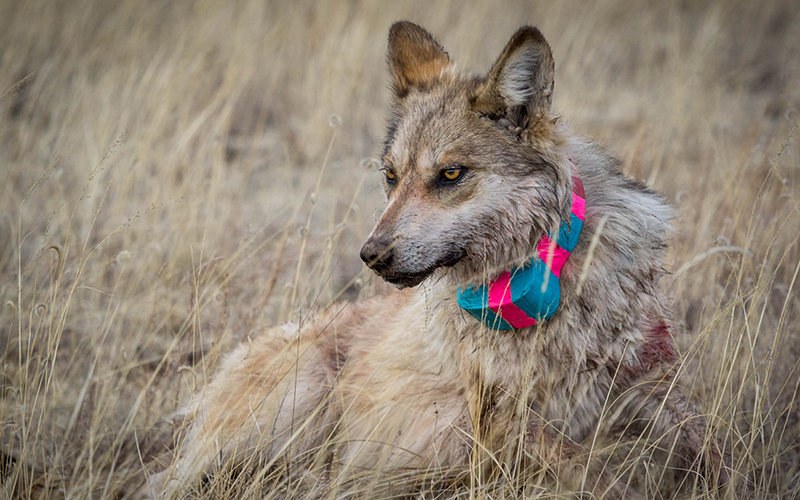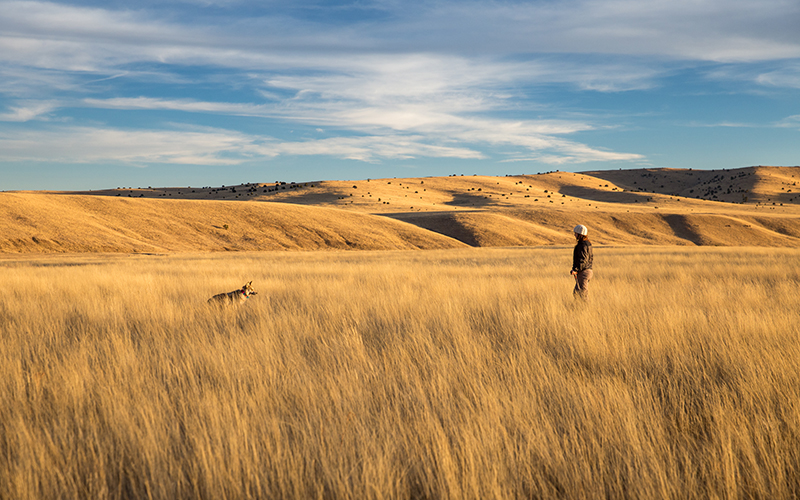
A Mexican gray wolf fitted with a radio collar in this 2018 photo. Tracking the animals in the wild is part of the years-long effort to reintroduce the subspecies, which was at the brink of extinction. (Photo by Jenna Miller/Cronkite News)
WASHINGTON – There were 14 more Mexican gray wolves in the wild last year, a “huge relief” to conservationists but not nearly enough for them to stop worrying about the long-term viability of the endangered animal.
The U.S. Fish and Wildlife Service reported Monday that it counted 131 Mexican gray wolves for 2018 – 64 in Arizona and 67 in New Mexico – up from 117 the year before. The increase came despite the documented deaths of 21 wolves last year, the report said.
Despite the increases, advocates say the endangered subspecies still faces genetic challenges from the small breeding population as well as the threat that a border wall could pose by cutting the U.S. packs off from wolves in Mexico.
“This is a huge relief,” said Michael Robinson, senior conservation advocate at the Center for Biological Diversity. “But there still need to be management changes if we are going to see sustained recovery.”
Amy Lueders, regional director of the Fish and Wildlife Service’s Southwest region, said in a statement that the results show the wolf is on its way back. There were just seven of the animals when reintroduction efforts began in 1998.
“The survey results indicate the Mexican wolf program is helping save an endangered subspecies,” Lueders said. “The Mexican wolf has come back from the brink of extinction, thanks to scientific management and the dedicated work of a lot of partners.”
The survey was done by the Mexican Wolf Interagency Field Team, federal, state and international partners that tracked the subspecies from November to January. The 131 wolves it counted were divided between 32 packs in southeastern Arizona and southwestern New Mexico, with seven lone wolves. It also found that 58% of the pups born last year survived.
Robinson said the increase is a relief, but a “genetic crisis is looming” for the wolves in the wild since every wolf is typically “related to every other wolf as if they were siblings.”
“The genetics of the Mexican wolf have been declining,” he said. “To be able to sustain population increases, we’re going to have to have significantly different management, including releases of family groups of wolves into the wild to diversify the gene pool.”
And Amanda Munro, field organizer for Southwest Environmental Center, said in a statement there may be new challenges looming for the subspecies, pointing to President Donald Trump’s proposed border wall, which she said “poses a huge threat to the Mexican gray wolf.”
“No matter if it’s made of concrete or steel, or if it’s called a wall or a fence, a border wall would make that genetic exchange impossible,” Munro said. “It would separate the Mexico and U.S. populations forever, and increase the risk of our lobo going locally extinct.”
The increase follows 20 years of reintroducing the subspecies into the wild after it had been hunted close to extinction.
The Mexican gray wolf is a subspecies of the more common gray wolf that inhabits the northern U.S. The northern wolf recently lost its protected status under the Endangered Species Act, but a National Academy of Sciences study released last month confirmed that the Mexican gray is a separate subspecies, meaning it retains its endangered status.
Jim deVos, assistant director of wildlife management for the Arizona Game and Fish Department, said in a statement that the latest population numbers “highlight the wolf’s progress in the wild.”
“The results of this census are very important as they reflect the great progress being made in the recovery of the Mexican wolf in the United States,” deVos’ statement said. “The increase of about 12 percent in the Mexican wolf population is not an isolated year, but rather a continuum of increases over the last 10 years.”
Advocates are still calling for more work, and Kelly Nokes, an attorney with the Western Environmental Law Center, said “we desperately need to release more Mexican wolves from the captive population into the wild” in order to bring the species back to full health.
“This critically imperiled species is relying on us to bring them back from the brink of extinction,” she said in a statement.
Robinson said despite the continuing challenges, “this is a moment for celebrating.”
“There’s more paws on the ground now than there were a year ago and that’s very good news,” he said.
This story is part of Elemental: Covering Sustainability, a new multimedia collaboration between Cronkite News, Arizona PBS, KJZZ, KPCC, Rocky Mountain PBS and PBS SoCal.
AlertMe
